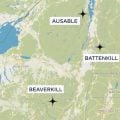Fishing in Vermont: The Long, Winding Road to Recovery
Hurricane Irene ripped through New England last August, causing severe flooding and catastrophic damage to any watershed in its path. Entire roads were washed away, bridges collapsed and sunken, people’s houses swallowed whole. No other state in New England suffered more than Vermont. The flooding that resulted was the worst the state has seen in 83 years. President Obama declared the state an emergency area, and soon the state was flooded with FEMA representatives and National Guardsmen, to help clean up the mess, and re-shape the rivers.

photos by Dawn Spencer
Once the excavators who had been parking in stream-beds were gone, many Vermont anglers returned to their favorite rivers and streams, only to find them empty of fish, and forever changed. The soil in the stream-bed had softened and eroded, most of the structure had been washed away, and major holes filled in by debris and washed out banks. The clarity in some of these rivers has yet to clear up, nearly four months later. The trout were scarce, or completely gone.
To make matters worse, a couple of state hatcheries were flooded by Irene’s onslaught. 15 inches of rain washed nearly 80,000 trout from their tanks and into the nearby woods and ditches around one hatchery. Another hatchery, responsible for not only stocking Vermont but parts of Lake Ontario as well, was flooded and infected with didymo, leaving both states (VT, NY) with no choice but to kill the fish suspected of infection. In a single moment, Vermont’s fisheries went from vigorous to sorely in need of long-term care.
But Rich Kirn, a fisheries biologist from the Vermont Department of Fish and Wildlife, suggests that the wild trout populations should see a rebound in about two to three years. He is basing his predictions on past data, collected from rivers in the northern part of the state that suffered from similar flood conditions. His data shows that the trout populations in those rivers were reduced to 33-58% of pre-flood levels. Creel surveys suggest that young fish were particularly affected by flooding, being reduced to 0-37% of pre-flood levels, and older trout fared slightly better, only being reduced to 41-64% of pre-flood levels.

A river ran through it! An entire road is washed into the Black River near Cavendish Vermont.
The good news: his data suggests that these rivers, and their trout populations, could be back to normal levels in the course of three years. The bad news: it may take decades for the river habitat to return to what it had been before the flood.
Kirn Writes:
In-stream flood recovery activities such as channelization, excessive stream-bed excavation and large scale natural wood removal greatly reduces the quality and diversity of aquatic habitats necessary to sustain fish and other aquatic populations. Different species and life-stages require a variety of habitat conditions to complete their life cycle. When aquatic habitats are degraded and homogenized, it requires many years or decades to recover, as these materials (cobbles, boulders, trees, etc.) must move in from upstream areas during high flows, and the river must slowly recreate pools, bends and other habitat features. The magnitude, extent and timing of in-stream flood recovery activities will ultimately determine the degree and longevity of the impacts to aquatic habitats and the populations they support. The ability of these populations to recover will depend upon successful reproduction and survival to older age classes. This can only occur if habitat conditions are in place to support these biological processes.
The biggest roadblock to in-stream flood recovery at this point is money. The state had to lean on the federal government for support in helping people rebuild their homes and properties. And the fish will also be waiting in line for help. But it could be a long wait in this challenging economy. Let’s hope these trout are as tough and resilient as “true Vermonters.”
Rally for the Colorado River
Minor Setback in Bristol Bay Case











